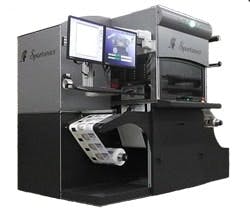Located in Rolling Meadows, Ill., Spartanics builds hard-tool and laser die-cutting machines, screen printing and re-registration equipment, machine-vision inspection and finishing systems, which produce everything from credit cards to automotive dashboards and displays. The firm was established in 1963, shortly after entrepreneur John Linton asked engineers Sam Willits and Bill Mohan to improve registration, and reduce frequent, costly manual errors when printing on and cutting metal nameplates. The two engineers were optical sensing experts at Chicago Aerial Industries, and developed an optical registration shear with a 30-in. blade, sensing heads and a motorized back gate, which improved accuracy to 0.001 in.
SEE ALSO: A Visible Cutting Edge
"The company started out in nameplates, but users also needed an optical, non-contact counter to go with the initial printer and cutting machine," says Tom Kleeman, CEO of Spartanics. "Next, the printed circuit board market grew up in the 1970s, which could use shearing equipment. But, they also needed pilot holes, so we invented pilot-hole punch presses with scanning sensors and AC servomotors to center the circuit boards."
Perhaps the biggest recent evolution for Spartanics arrived about eight years ago when it implemented optically-directed laser cutting to accelerate production of digitally printed credit cards, labels, decorative products and other die-cut items. These laser die-cutting systems use mirror-galvanometers to position their cutting beams, and are integrated with Spartanics' registration, counting, feeding and material handling lines. The firm employs its own proprietary motion-control components and software for its laser cutters, including elements that took 10 years to develop. However, it also adopted some off-the-shelf servomotors and drives, as well as PLCs for high- and low-end control.
"We're also starting to use PC-based control software for laser cutting, but we mainly write our programming in Visual Basic V.6, move it into a Microsoft .Net environment, and use C# and C++," Kleeman says. "We have the fastest laser cutters around because of how we've edited and optimized our software, which looks like CNC code. Laser cutting is lot like running an old X-Y plotter, but in this case we're using mirrors to steer a beam to different points on a flat surface that's moving. Interfacing with our users helps us develop and implement better software for them, but our optics experience and knowing the physics behind the lasers and galvanometers lets us achieve the highest cutting speeds by shortening our distances, finding the best geometries, and picking the best start and stop times with the least oscillation."







